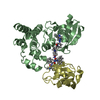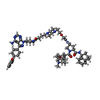+ Open data
Open data
- Basic information
Basic information
| Entry | Database: PDB / ID: 8dso | ||||||
|---|---|---|---|---|---|---|---|
| Title | Structure of cIAP1, BTK and BCCov | ||||||
 Components Components |
| ||||||
 Keywords Keywords | ONCOPROTEIN / E3 Ligase / PROTAC / Ternary Complex / BTK | ||||||
| Function / homology |  Function and homology information Function and homology informationnegative regulation of ripoptosome assembly involved in necroptotic process / FBXO family protein binding / regulation of RIG-I signaling pathway / positive regulation of protein K48-linked ubiquitination / regulation of non-canonical NF-kappaB signal transduction / TNF receptor superfamily (TNFSF) members mediating non-canonical NF-kB pathway / regulation of B cell cytokine production / regulation of necroptotic process / positive regulation of protein K63-linked ubiquitination / regulation of B cell apoptotic process ...negative regulation of ripoptosome assembly involved in necroptotic process / FBXO family protein binding / regulation of RIG-I signaling pathway / positive regulation of protein K48-linked ubiquitination / regulation of non-canonical NF-kappaB signal transduction / TNF receptor superfamily (TNFSF) members mediating non-canonical NF-kB pathway / regulation of B cell cytokine production / regulation of necroptotic process / positive regulation of protein K63-linked ubiquitination / regulation of B cell apoptotic process / regulation of nucleotide-binding domain, leucine rich repeat containing receptor signaling pathway / monocyte proliferation / positive regulation of interleukin-17A production / eosinophil homeostasis / proteoglycan catabolic process / CD40 receptor complex / positive regulation of type III hypersensitivity / B cell affinity maturation / positive regulation of synoviocyte proliferation / histamine secretion by mast cell / neutrophil homeostasis / positive regulation of cGAS/STING signaling pathway / cellular response to molecule of fungal origin / XY body / negative regulation of necroptotic process / positive regulation of type I hypersensitivity / cysteine-type endopeptidase inhibitor activity involved in apoptotic process / MyD88 deficiency (TLR2/4) / cellular response to interleukin-7 / non-canonical NF-kappaB signal transduction / TNFR1-induced proapoptotic signaling / positive regulation of protein monoubiquitination / IRAK4 deficiency (TLR2/4) / MyD88-dependent toll-like receptor signaling pathway / MyD88:MAL(TIRAP) cascade initiated on plasma membrane / RIPK1-mediated regulated necrosis / regulation of reactive oxygen species metabolic process / positive regulation of B cell differentiation / positive regulation of immunoglobulin production / phospholipase activator activity / regulation of toll-like receptor signaling pathway / negative regulation of interleukin-10 production / regulation of innate immune response / Apoptotic cleavage of cellular proteins / negative regulation of B cell proliferation / positive regulation of NLRP3 inflammasome complex assembly / Fc-epsilon receptor signaling pathway / mesoderm development / necroptotic process / B cell activation / phosphatidylinositol-3,4,5-trisphosphate binding / regulation of cell differentiation / response to cAMP / canonical NF-kappaB signal transduction / RHO GTPases Activate WASPs and WAVEs / phospholipase binding / cell maturation / positive regulation of B cell proliferation / FCERI mediated Ca+2 mobilization / positive regulation of phagocytosis / Antigen activates B Cell Receptor (BCR) leading to generation of second messengers / peptidyl-tyrosine phosphorylation / TICAM1, RIP1-mediated IKK complex recruitment / placenta development / IKK complex recruitment mediated by RIP1 / ubiquitin binding / positive regulation of protein ubiquitination / tumor necrosis factor-mediated signaling pathway / TNFR1-induced NF-kappa-B signaling pathway / cellular response to reactive oxygen species / B cell receptor signaling pathway / TNFR2 non-canonical NF-kB pathway / non-membrane spanning protein tyrosine kinase activity / FCGR3A-mediated phagocytosis / non-specific protein-tyrosine kinase / apoptotic signaling pathway / Regulation of TNFR1 signaling / calcium-mediated signaling / NOD1/2 Signaling Pathway / positive regulation of NF-kappaB transcription factor activity / RING-type E3 ubiquitin transferase / Regulation of actin dynamics for phagocytic cup formation / Regulation of necroptotic cell death / positive regulation of interleukin-6 production / cytoplasmic side of plasma membrane / protein polyubiquitination / G beta:gamma signalling through BTK / ubiquitin-protein transferase activity / positive regulation of tumor necrosis factor production / ubiquitin protein ligase activity / DAP12 signaling / G alpha (12/13) signalling events / T cell receptor signaling pathway / regulation of cell population proliferation / protein-folding chaperone binding / transferase activity / ER-Phagosome pathway / regulation of inflammatory response / cytoplasmic vesicle / protein tyrosine kinase activity Similarity search - Function | ||||||
| Biological species |  Homo sapiens (human) Homo sapiens (human) | ||||||
| Method |  X-RAY DIFFRACTION / X-RAY DIFFRACTION /  SYNCHROTRON / SYNCHROTRON /  MOLECULAR REPLACEMENT / Resolution: 2.334 Å MOLECULAR REPLACEMENT / Resolution: 2.334 Å | ||||||
 Authors Authors | Schiemer, J.S. / Calabrese, M.F. | ||||||
| Funding support | 1items
| ||||||
 Citation Citation |  Journal: Nat Commun / Year: 2023 Journal: Nat Commun / Year: 2023Title: A covalent BTK ternary complex compatible with targeted protein degradation. Authors: Schiemer, J. / Maxwell, A. / Horst, R. / Liu, S. / Uccello, D.P. / Borzilleri, K. / Rajamohan, N. / Brown, M.F. / Calabrese, M.F. | ||||||
| History |
|
- Structure visualization
Structure visualization
| Structure viewer | Molecule:  Molmil Molmil Jmol/JSmol Jmol/JSmol |
|---|
- Downloads & links
Downloads & links
- Download
Download
| PDBx/mmCIF format |  8dso.cif.gz 8dso.cif.gz | 92.3 KB | Display |  PDBx/mmCIF format PDBx/mmCIF format |
|---|---|---|---|---|
| PDB format |  pdb8dso.ent.gz pdb8dso.ent.gz | 65.8 KB | Display |  PDB format PDB format |
| PDBx/mmJSON format |  8dso.json.gz 8dso.json.gz | Tree view |  PDBx/mmJSON format PDBx/mmJSON format | |
| Others |  Other downloads Other downloads |
-Validation report
| Summary document |  8dso_validation.pdf.gz 8dso_validation.pdf.gz | 761.9 KB | Display |  wwPDB validaton report wwPDB validaton report |
|---|---|---|---|---|
| Full document |  8dso_full_validation.pdf.gz 8dso_full_validation.pdf.gz | 765.9 KB | Display | |
| Data in XML |  8dso_validation.xml.gz 8dso_validation.xml.gz | 16 KB | Display | |
| Data in CIF |  8dso_validation.cif.gz 8dso_validation.cif.gz | 21.9 KB | Display | |
| Arichive directory |  https://data.pdbj.org/pub/pdb/validation_reports/ds/8dso https://data.pdbj.org/pub/pdb/validation_reports/ds/8dso ftp://data.pdbj.org/pub/pdb/validation_reports/ds/8dso ftp://data.pdbj.org/pub/pdb/validation_reports/ds/8dso | HTTPS FTP |
-Related structure data
| Related structure data |  8dsfC  5p9jS C: citing same article ( S: Starting model for refinement |
|---|---|
| Similar structure data | Similarity search - Function & homology  F&H Search F&H Search |
- Links
Links
- Assembly
Assembly
| Deposited unit | 
| ||||||||
|---|---|---|---|---|---|---|---|---|---|
| 1 |
| ||||||||
| Unit cell |
|
- Components
Components
| #1: Protein | Mass: 32112.816 Da / Num. of mol.: 1 Source method: isolated from a genetically manipulated source Source: (gene. exp.)  Homo sapiens (human) / Gene: BTK, AGMX1, ATK, BPK Homo sapiens (human) / Gene: BTK, AGMX1, ATK, BPKProduction host:  Spodoptera aff. frugiperda 2 RZ-2014 (butterflies/moths) Spodoptera aff. frugiperda 2 RZ-2014 (butterflies/moths)References: UniProt: Q06187, non-specific protein-tyrosine kinase |
|---|---|
| #2: Protein | Mass: 11318.731 Da / Num. of mol.: 1 Source method: isolated from a genetically manipulated source Source: (gene. exp.)  Homo sapiens (human) / Gene: BIRC2, API1, MIHB, RNF48 / Production host: Homo sapiens (human) / Gene: BIRC2, API1, MIHB, RNF48 / Production host:  References: UniProt: Q13490, RING-type E3 ubiquitin transferase |
| #3: Chemical | ChemComp-TOO / ( |
| #4: Chemical | ChemComp-ZN / |
| #5: Water | ChemComp-HOH / |
| Has ligand of interest | Y |
| Has protein modification | Y |
-Experimental details
-Experiment
| Experiment | Method:  X-RAY DIFFRACTION / Number of used crystals: 1 X-RAY DIFFRACTION / Number of used crystals: 1 |
|---|
- Sample preparation
Sample preparation
| Crystal | Density Matthews: 3.99 Å3/Da / Density % sol: 70.22 % |
|---|---|
| Crystal grow | Temperature: 293 K / Method: vapor diffusion, sitting drop / pH: 9 Details: 0.1 M BTP pH 9, 4M potassium formate, and 2% PEG MME 2K |
-Data collection
| Diffraction | Mean temperature: 100 K / Serial crystal experiment: N |
|---|---|
| Diffraction source | Source:  SYNCHROTRON / Site: SYNCHROTRON / Site:  APS APS  / Beamline: 17-ID / Wavelength: 1 Å / Beamline: 17-ID / Wavelength: 1 Å |
| Detector | Type: DECTRIS PILATUS3 S 6M / Detector: PIXEL / Date: Apr 11, 2019 |
| Radiation | Protocol: SINGLE WAVELENGTH / Monochromatic (M) / Laue (L): M / Scattering type: x-ray |
| Radiation wavelength | Wavelength: 1 Å / Relative weight: 1 |
| Reflection | Resolution: 2.334→110.29 Å / Num. obs: 17804 / % possible obs: 88.9 % / Redundancy: 9.9 % / Rpim(I) all: 0.113 / Net I/σ(I): 4.7 |
| Reflection shell | Resolution: 2.337→2.734 Å / Num. unique obs: 890 / Rpim(I) all: 0.551 |
- Processing
Processing
| Software |
| ||||||||||||||||||||||||||||||||||||||||||||||||||||||||||||
|---|---|---|---|---|---|---|---|---|---|---|---|---|---|---|---|---|---|---|---|---|---|---|---|---|---|---|---|---|---|---|---|---|---|---|---|---|---|---|---|---|---|---|---|---|---|---|---|---|---|---|---|---|---|---|---|---|---|---|---|---|---|
| Refinement | Method to determine structure:  MOLECULAR REPLACEMENT MOLECULAR REPLACEMENTStarting model: 5p9j Resolution: 2.334→110.29 Å / Cor.coef. Fo:Fc: 0.903 / Cor.coef. Fo:Fc free: 0.88 / SU R Cruickshank DPI: 0.456 / Cross valid method: THROUGHOUT / SU R Blow DPI: 0.446 / SU Rfree Blow DPI: 0.319 / SU Rfree Cruickshank DPI: 0.322
| ||||||||||||||||||||||||||||||||||||||||||||||||||||||||||||
| Displacement parameters | Biso mean: 70.79 Å2
| ||||||||||||||||||||||||||||||||||||||||||||||||||||||||||||
| Refine analyze | Luzzati coordinate error obs: 0.41 Å | ||||||||||||||||||||||||||||||||||||||||||||||||||||||||||||
| Refinement step | Cycle: LAST / Resolution: 2.334→110.29 Å
| ||||||||||||||||||||||||||||||||||||||||||||||||||||||||||||
| Refine LS restraints |
| ||||||||||||||||||||||||||||||||||||||||||||||||||||||||||||
| LS refinement shell | Resolution: 2.334→2.53 Å
|
 Movie
Movie Controller
Controller



 PDBj
PDBj

























